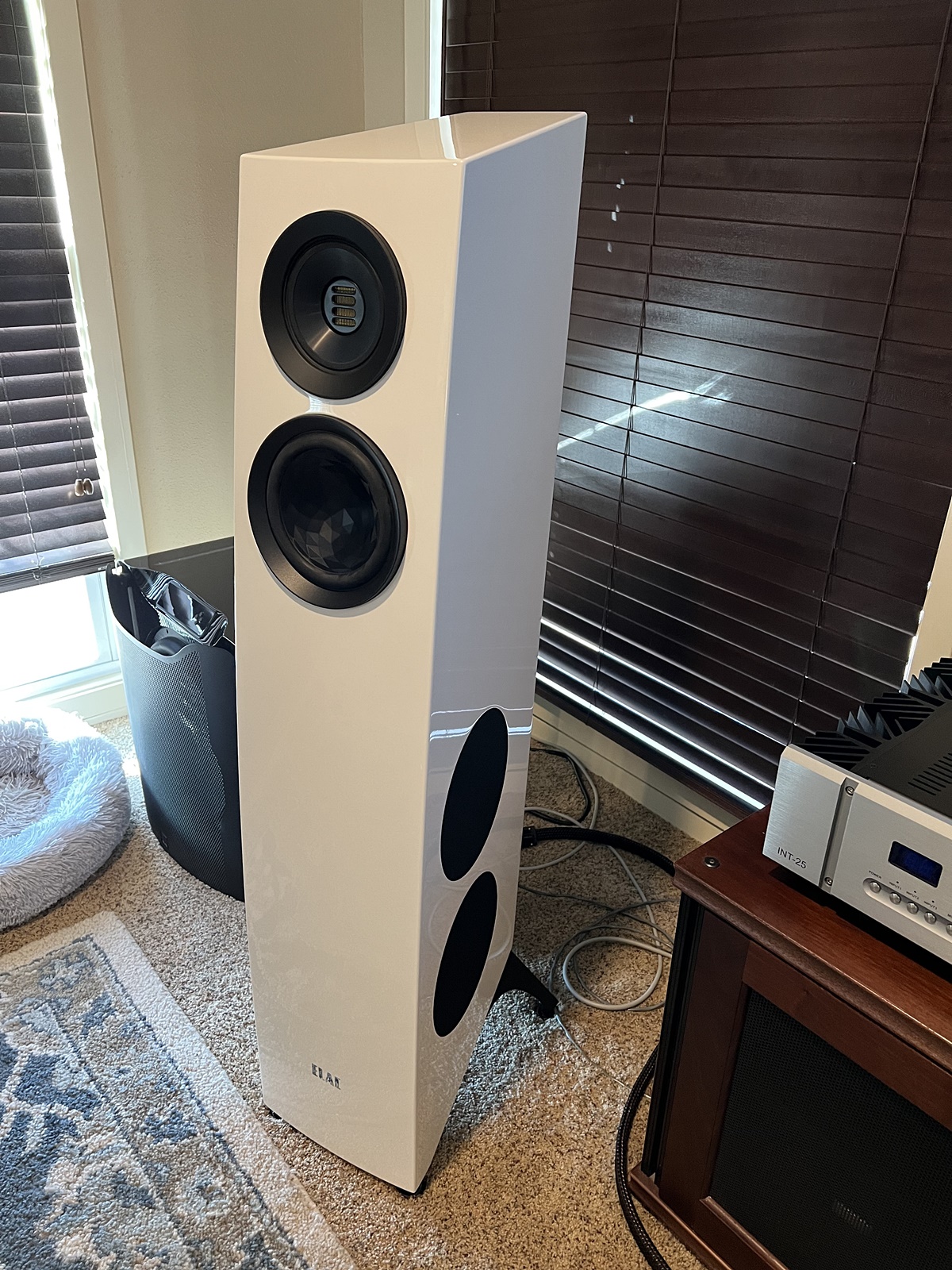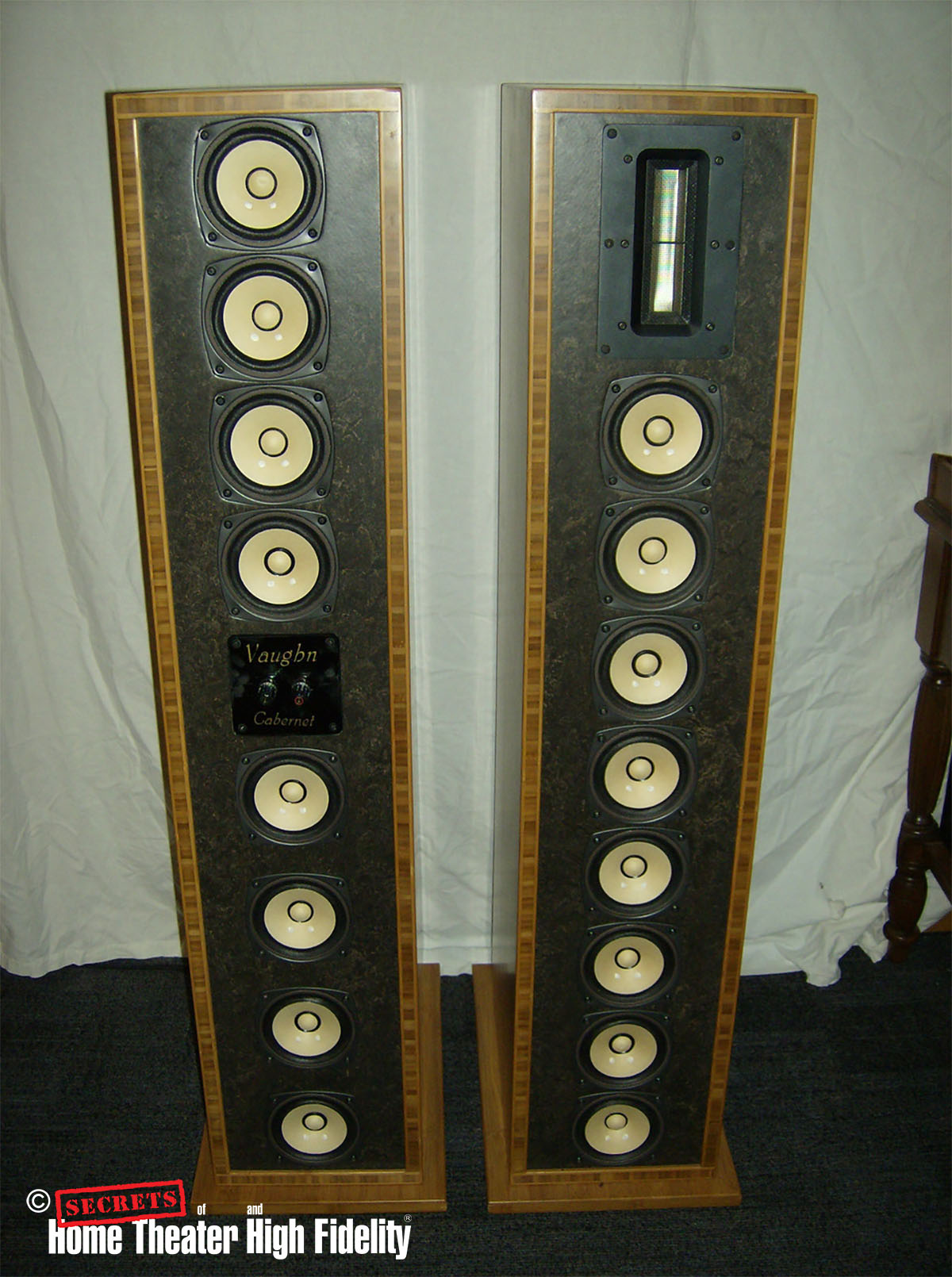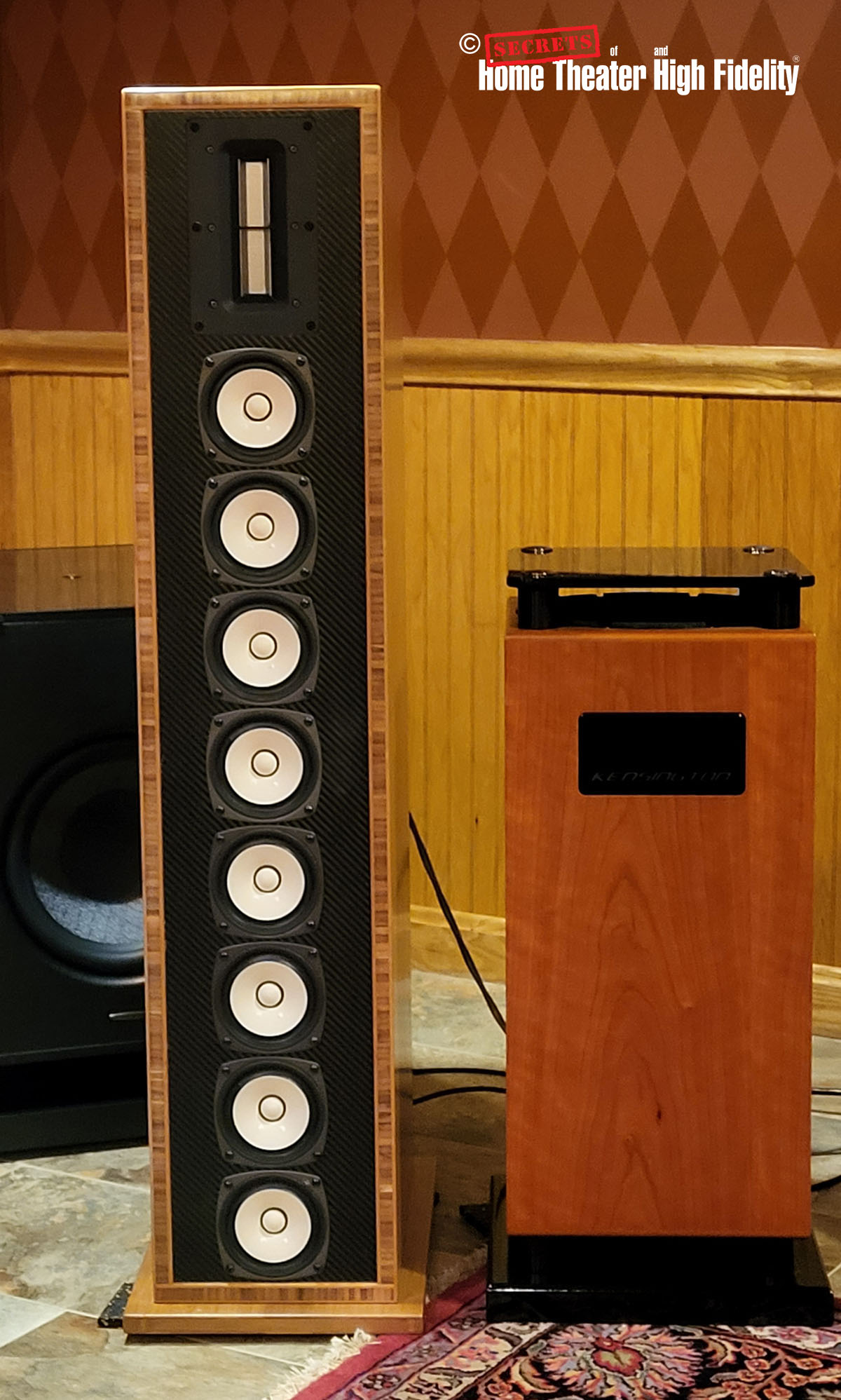Jim Jordan spent over eight years designing what ultimately became the Line Array system. His philosophy is in the “form follows function” arena of design, and he followed through with this concept in not only the speaker’s design but in its moniker. Line Array Major is the full name of this unusual speaker, and Mr. Jordan was confident enough in its design that he and his lovely wife took a 114-hour round trip to deliver them (and a pair of MJ Acoustics subwoofers) to our place in Pennsylvania.
Vaughn Loudspeaker Line Array Major Speaker Highlights
- 100dB sensitivity.
- Sixteen 4-inch full-range drivers in a bi-pole arrangement.
- Dual 12-inch passive radiators.
- Ribbon tweeter.
- Full-range drivers operate from 80 to 8,500Hz without a crossover.
- First order crossover from full-range drivers to the tweeter at 8,500Hz, essentially allowing a full-range performance without the compromises most full-range systems have.
- Designed to be used with a single or pair of dedicated subwoofers.
- Bamboo-ply cabinet.
- Loves tube amplifiers.
- Despite what Jim Jordan says, loves solid-state amps, too!
Vaughn Loudspeakers is not a company with which most audiophiles have any experience. I stumbled on their website a few months ago after doing a search for “speakers made in the USA.” They have received many mentions at various audio shows over the years, but very few all-out reviews. This does not seem to deter the owner of the company, Jim Jordan, from his unabashed enthusiasm for his products. His goal is to bring sound quality to the end user in a reasonably sized package. He spends countless hours tweaking his designs, and a visit to his website will show a variety of products. After several months of discussion, we decided to put the Line Array Major speaker system to the test. Is this system a potential giant killer in the speaker world?
Type:
Bipole floor-standing loudspeaker
Main Drivers:
16x wide range, 4-inch drivers (8x front, 8x rear)
Tweeter:
1x ribbon
Passive Radiators:
2x 12-inch
Crossover:
First order @ 8,500Hz
Sensitivity:
100dB / 2.83 Volts / 1 meter
Impedance:
8 Ohms
Response:
70-20,000Hz
Power:
2 watts minimum, 120 watts maximum
Size:
44 inches tall x 15.5 inches deep x 9.5 inches wide
Weight:
94 pounds each
Warranty:
5 years
Cabinet:
Bamboo Ply
MSRP:
$9000 per pair plus your choice of subwoofers (more on this later)
Website:
SECRETS Tags:
speakers, speakers reviews, speakers reviews 2023, vaughn speakers, vaughn speakers reviews, vaughn speakers reviews 2023,Vaughn loudspeakers, line array major, line array speaker, tower speaker, floor-standing speaker
- Goldenear Triton Three Loudspeaker Review
- MartinLogan Statement 40xw In Wall Loudspeaker Review
- Canton Vento 100 Floor Standing Speaker Review
Jim Jordan’s stated design goal was to engineer a loudspeaker with all the openness and sound stage of the world’s best planar speakers (think Magnepan, Apogee, Martin Logan, Acoustat, and Quad) without their limits in terms of macro dynamics. He also wanted them to be able to create sufficient SPL levels with lower-powered tube amps. And he wanted to keep them affordable.
The eight four-inch drivers on the front and rear baffles each have about the same effective radiating surface as would a single 11.5-inch driver on each baffle, but without the limitations of that 11.5-inch driver. By keeping the effective range of the drivers in that 80-8,500Hz range, Mr. Jordan also kept the excursion, and distortion, to a minimum. These drivers are highly efficient and can deliver well more than 118dB into a room without audible distortion.
Secrets Sponsor
The Line Array Majors are meant to be used with high-quality subwoofers, and for this review, three separate subwoofer systems were auditioned: The $2,000 Martin Logan Dynamo 1600X and the $2,000 Axiom EP600 were used to research how well the Line Arrays might work with quality subwoofers that Vaughn Loudspeakers does not sell, and they acquitted themselves quite well. Mr. Jordan is a big fan of MJ Acoustics subwoofers and carries the line to augment the Line Array Majors. His recommended systems start at $10,389 for the Line Array plus a single MJ Acoustics REF 200 sub to $17,000 for the Line Arrays with a pair of Kensington subwoofers. All packages will deliver bass to below 20Hz. The entry-level REF 200 system uses a single 10-inch driver with a MOSFET 200-watt amp to the pair of Kensington subs having a total of FOUR 10-inch drivers with 1,100 watts of MOSFET power driving them.
The system used for the critical listening sessions was with the MJ Acoustics Kensington subwoofer as both a single sub ($13,000 total system) and as a pair ($17,000 total system). Mr. Jordan is more than happy to assist each purchaser in selecting the right subwoofer package. We will dig deep to ascertain this speaker system’s overall value as a $13,000 to $17,000 package. If you already have an excellent subwoofer system, and the $9,000 entry price for these speakers appeals to you, but the extra cost of new subwoofers puts you off, our experience with the Martin Logan and Axiom subwoofers demonstrated that the Line Arrays can deliver excellent results with a variety of high-quality subs.
The third part of the performance is the ribbon tweeter that takes over from the driver array at 8,500Hz. While this is a passive loudspeaker, NOT having any crossover in that all-important 80-8,500 Hz range leads to a much purer performance than one would typically see in a normal three-way speaker. With a few possible exceptions, all music fundamentals occur below the 8,500Hz crossover point of the Line Array Majors. The arena above 8,500Hz deals with the harmonics of the music experience. The ribbon tweeter is rolled in using a first-order (6dB per octave) crossover that Mr. Jordan spent years perfecting. It extends beyond 20,000 Hz and provides what we typically think of as air in a speaker.
Secrets Sponsor
The cabinets are of exceptional quality. The bamboo ply with the beautiful veneer (pictures don’t do these speakers justice) passes both the knuckle rap test and the beauty test. The carbon fiber baffle adds to the look and these speakers say furniture quality from top to bottom.
What we have is the promise of a speaker system that, with the right subwoofer, can deliver all the SPL one could want from well below 20Hz to well above 20,000Hz. The wide dispersion characteristics of the bipolar main array and the grounded-in-science decisions made by Jim Jordan have all the promise of a super speaker for well under $20,000. It may take a little more thought to complete the system than usual, so let’s find out if the required effort is worth it!
As mentioned earlier, Jim and his bride drove the Line Array Major set (along with the MJ Acoustic Kensington subwoofers) to our place, and even though it wasn’t necessary for hand delivery, the boxes and Styrofoam padding seemed stout enough for normal truck shipping. During the unpacking, it was nice to notice the bases for the speakers were integrated into the speakers, with no assembly required.
We used several pre-amp/power amp combinations from Parasound (New Classic 200 Pre-Amp), Michi’s S5 power amp, Cambridge Audio Edge NQ Pre-amp, and matching Edge W Power amplifier and the all-tube Rogers KWM-88 amplifier. CD and SACD tracks were provided by the Yamaha CD-2100 player. Speaker cables were the Blue Jeans Cable 10AWG in eight-foot lengths, while the interconnects were the Better Cables Silver Serpent AIR in one-meter runs.
The various amplifier combinations we used are all very linear in response curves. Jim Jordan loves the sound of lower-powered tube amps – which also typically have a higher output impedance and response curves that are, while not linear, pleasing to the ear. I don’t have any such amplifiers here at this time, but am quite confident that after living with the Line Array Majors for a few weeks, they can deliver excellent results with a three-watt amp. In running pink noise, they measured, at my listening position, 10dB higher SPL than did the Sonus faber Maxima Amators and were comparable to Heretic Loudspeaker AD-612 monitors.
In terms of placement, they are 35 inches from the wall behind them and 12 feet apart, which is wider than the normal placement for speakers in our listening room. They are toed in about 10 degrees, which is a real sweet spot in our room. Placement for good sound with the Line Array Majors was one of the easiest jobs I ever had, and they are a loudspeaker that does not require much fussing about to achieve excellent results. Setting up them for excellent results, even with the subwoofers, was not as difficult as I thought it would be.
For all the listening tests reported here and the measured response curve you will see later, I used the MJ Acoustics Kensington subwoofer pair ($8,000) for a total package price of $17,000. The subs were placed next to each speaker, and as you will see later in the response curve, they did a stellar job in delivering bass to 20Hz and below. Let’s find out how well the Line Array Major system with MJ Acoustics Kensington subwoofers performs in listening tests!
This disc was assembled by the fine folks who work with Grandinote and Tingsha Audio for a system with a six digits price tag, and it has become a true go-to compilation for assessing loudspeakers.
We start with Béla Fleck’s “Flight of the Cosmic Hippo,” where the speaker is required to handle an incredibly detailed bass track while also rendering the guitar work. The Line Array Major and Kensington system were already knocking it “out da’ park,” in terms of sheer listening pleasure. The Kensington’s mesh so well with the Line Array Majors that turning off the subwoofer while running the speakers full range loses the deep bass. Turning the sub back on brings back the bass without a hint of boom. The speakers also managed that magical feat that great speakers do, they disappeared. One could not tell that the sound was emanating from a pair of loudspeakers. The music was merely “there,” with a massively wide and deep sound stage.
We then hit Yello’s “Rubberbandman,” which features a terrific baritone vocal percussion with a synthesized whip sound background laughter and a general feeling of a bunch of guys having a blast making music. The vocals have no chestiness, and that whip sound goes across the sound stage with a quickness one expects from a very well-designed planar speaker.
Dede Priest’s “Blue Wine” is next, and we are witnessing her voice coming from a totally silent background. For tonality, this $17,000 is reminding me a lot of an audition of a pair of Wilson Audio’s Alexx V loudspeakers being driven by some McIntosh monoblock amplifiers on a recent audio trip. The experience had me wanting to put together a blind listening test between the two systems.
As we move forward to later tracks, we have an upright bass that is so clear that one can easily hear the strings hit the body of the instrument when the player gets a little rowdy. We are talking clarity that exceeds some really good loudspeakers that we have tested recently, and that I purchased to keep as a reference.
Buddy Guy’s “Love the Life I Live” shows off the multiple four-inch driver’s ability to go loud and then go quiet with such ease and a ‘see into the sound stage’ effect that it is a revelation. Every track and every instrument (especially human voices) are crystal clear without a hint of harshness, even at volume levels I rarely attempt. Having over 400 square inches of quality drivers with no crossover in the reproduction of any of the music’s fundamentals pays off in a big way.
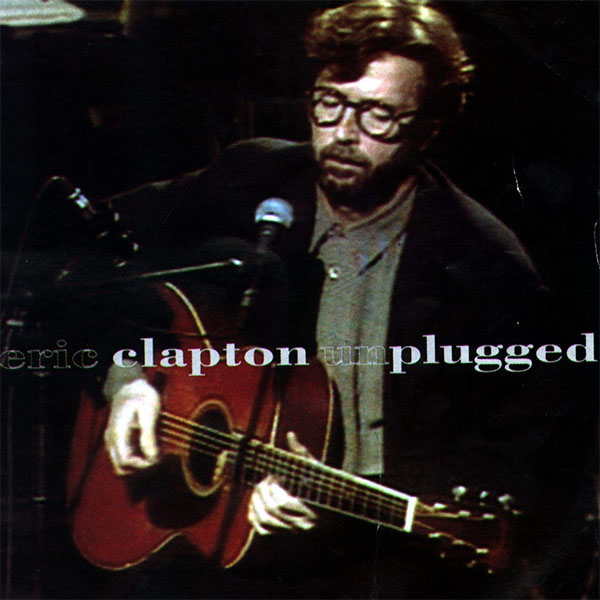
Eric Clapton “Unplugged”
Recorded in 1992, Unplugged has everything a growing speaker company needs to show off the talents of its designer and builders. After the short intro “Signe,” we move into “Before You Accuse Me,” a Blues tune that has the male singer ‘splainin’ to his female partner that he’s not behaving any worse than she is. It’s a song that better speakers handle with excellent tempo, and the symbiotic relationship of the MJ subs and the Line Array Majors presents itself with that “you are there” quality including a deep and wide sound stage, and the feeling that the performers are almost with you (nothing matches live, but this was close). Clapton’s acoustic guitar is rendered with authority, including a perfect weight to the feeling one gets when an accomplished guitarist’s hands hit the body of the instrument, bringing the percussion into reality.
“Tears in Heaven,” written less than a year after the still tragic death of his son, is heart-wrenching. Clapton’s voice shows he is still in mourning over his loss, and it’s almost impossible to not get choked up when listening to it. The Line Array Majors made this track even more emotional than most speakers, as that lack of crossover for all of Clapton’s voice range, combined with a total lack of distortion, makes for as good a reproduction of this track as I have experienced with any loudspeaker. One of the aspects of a loudspeaker that I have learned to respect over the years is one which makes me put down the remote and enjoy every song on the disc. The Line Array Majors (and sub) handled this with such ease that I not only listened to the disc in its entirety but wanted to listen to it again.
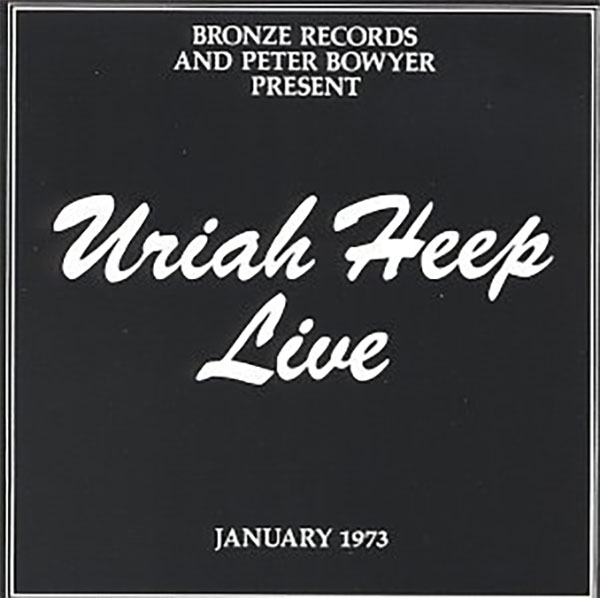
Enter The Rogers High Fidelity KWM-88 “Uriah Heep Live: 1973”
I was introduced to Uriah Heep in 1973 by my older brother, and this is my all-time favorite album of theirs. In most cases, a ‘live’ album is not done as well in terms of pure sound quality than is a studio album. Uriah Heep’s 1973 concert recording from Birmingham, England is one of the exceptions to this rule.
Rolling Stone Magazine once referred to Uriah Heep as “The Beach Boys meet Heavy Metal,” and this is an apt description. David Byron, whom we lost WAY too early in 1983, had a unique voice, especially in terms of his vocal range. I would love to have seen him and
Robert Plant on stage together!
This catalog of Uriah Heep’s hits has some of the best live recordings of drums and guitars that one will hear, and the keyboards (including organ) are powerful and immersive. The opening track “Sunrise” starts with the organ, then the drum, the band harmonizing, and finally Mr. Byron kicking in with his vocals. Song after song, for well over an hour, the Line Array Majors played with such clarity and a total lack of distortion that one got the feeling of listening to speakers with the power of Klipschorns, the clarity of a great British monitor from the likes of Spendor or Harbeth and the grandeur of sound stage from a pair of larger planar speakers such as a pair of Magnepan 20.7’s.
The subwoofers added a depth of bass that was so in tune with the main speakers that one could not tell they were operating unless one turned them off.
The Rogers KWM-88 is a true reference quality tube amp – offering more than 100 watts per channel of Class A tube power and turning this system into a super system for about $33,500 retail price.
Of particular note is the anthem “Circle of Hands,” which starts slowly and builds to a crescendo during its nine-minute run time that will leave many speakers breathless. The Line Array Majors never even flinched, and are so efficient that the Roger’s amp wasn’t even breaking a sweat. A case could be made that one of Roger’s lower-powered tube amps (under $5,000) would yield similar results and make this outstanding performance even more affordable. We may have to try out some lower-powered tube amps later this year, especially with the Line Array Majors.
The Combo of the Line Arrays and the Rogers Tube Amp Has Me Hooked
After experiencing the wonders of the now 50-year-old Uriah Heep concert, I became enthused (some might say obsessed) with listening to a variety of music and video sources over the next few weeks. The previously mentioned “Extended Dynamics Experience 4” disc covers all the audiophile tracks one could ever need. This was now a time to have some fun.

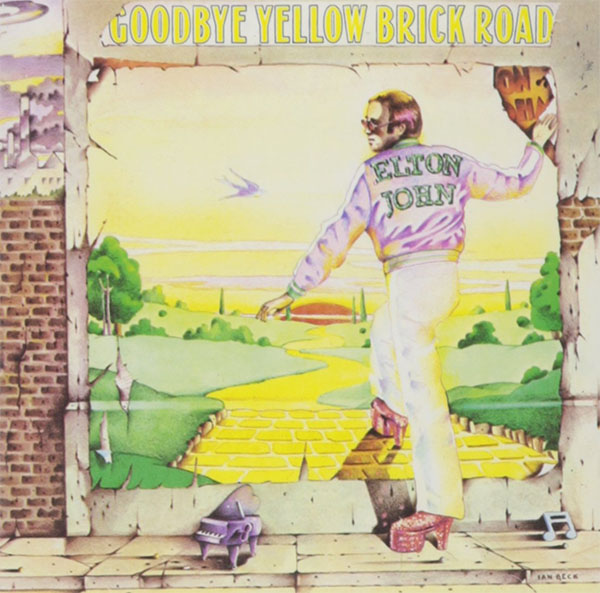
Elton John “Goodbye Yellow Brick Road”
Elton John’s “Goodbye Yellow Brick Road” CD brought out every nuance of “Funeral For a Friend/Love Lies Bleeding” with a see-through quality we could only dream of in the 1970s. As with many other albums, the Line Array Majors had me listening to both discs and loving every minute of it.
Pink Floyd’s “Pulse,” David Sanborn Live, Masters of Acoustic Guitar CD … disc after disc and show after show, the Line Arrays made January (which is the most depressing month of the year, according to one of those recent studies) a LOT more fun.
Most loudspeaker systems are specified into a response curve with a window of +3dB across the bandwidth at which the speaker operates. An example would be +3dB from 40 to 20,000Hz. This spec is in a no-boundaries arena – either outdoors or in an anechoic chamber with no room effect.
Many quality publications now include, in testing, a response curve at the listening position, as we want to see what type of response curve the reviewer is hearing. Most of these curves end up being about +6dB from 63 to 10,000Hz with a roll-off above 10,000Hz. Below 63Hz, we often see a bass bump thanks to room gain.
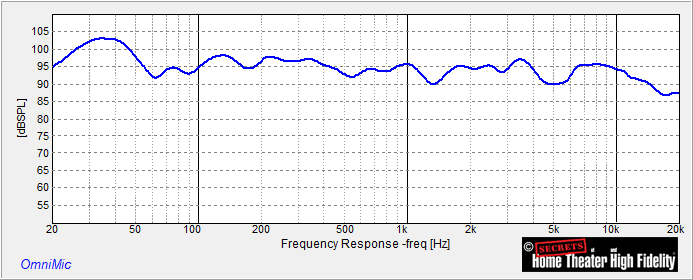
The Line Array Majors with subs managed to deliver a +4dB response curve from 50Hz to beyond 10,000Hz in room with no room correction applied. Even more importantly, they delivered within +3dB from 60 to 1,000 Hz – which is where the vast majority of the music lives.

What is even more impressive is the distortion curve. I normally measure distortion using an 85dB signal across the bandwidth at my listening position, which would be about 94dB at one meter from the speaker. For the Line Array Majors, a 95dB signal at the listening position was used – a full 10dB above the normal test. This was loud enough that I wore earbuds for protection while taking the measurements. This is a slow sine wave, and not an enjoyable listen. It’s also a very difficult test for a speaker.
Let’s look at some distortion data from 80Hz and up. The black line is the frequency sweep, and the blue line is the THD+N. Any point with a 40 dB or greater spread between the lines is 1% THD or less. At 80-160Hz, we saw nothing higher than 1.47% THD. Above 160Hz, the THD was below 0.5%, hitting a low of 0.14% at 1,000Hz. This is an astonishing performance and dovetails perfectly with the listening results we obtained with the Vaughn Line Array Majors.
Vaughn’s Line Array Major Loudspeakers and MJ Acoustics Kensington Subwoofers combine to bring world-class sound from below 20Hz to above 20,000Hz in a $17,000 package.
- Lowest THD I have experienced in our room.
- Massive sound stage in depth and width.
- Male vocals presented with authority yet without boom.
- Bamboo cabinets are beautiful and pass the knuckle rap test with ease.
- Can be driven with a good five-watt amp.
- Company owner who answers the phone when you call.
- Simple integration with several different subwoofer systems.
- My family’s reaction when playing classic rock on these speakers.
- A simpler way for more people to audition them.
James Jordan started his communication with me several months before getting the Line Array Major speakers in our system. We talked and emailed for three months before selecting this exact package of the Line Array Majors and Kensington subwoofers.
The entire concept of wide frequency response drivers with no crossover in the majority of the audible bandwidth plus the sheer ability of 16 four-inch drivers per cabinet caught my attention as being a solid approach to making a speaker with few limitations. When one factors into the equation just how easy it is to drive them, including with low-powered tube amps, the value becomes even more evident.
The execution is what ultimately made this one of the most enjoyable speaker reviews (which is really a long-term audition) that I have ever experienced. The fact that the entry point for this system is $9,000 if the buyer already has good subwoofers makes for an even higher level of respect from this reviewer.
I would be remiss if I didn’t discuss the performance of the ribbon tweeter. It is established that we can hear for approximately 10 octaves, from 20 to 20,000Hz. In this overall speaker package, the subwoofers will account for the bottom two octaves out of those 10. The 16 four-inch drivers per side cover roughly seven octaves before handing off the top octave to the ribbon tweeter.
This ribbon tweeter is so well designed and integrated into this speaker system with the custom-designed, first-order crossover, that it never calls attention to itself. It just adds that last bit of air to the music by extending the response curve beyond the 10th octave top (20,000 Hz) to 40,000Hz, adding another octave to this speaker system’s response. One might even say that the Vaughn Line Array truly DOES go to 11!
Congratulations are in order for Mr. Jordan and his years of work perfecting these speakers. This is a wonderful achievement in the world of loudspeakers.
Well done, James Vaughn Jordan.


